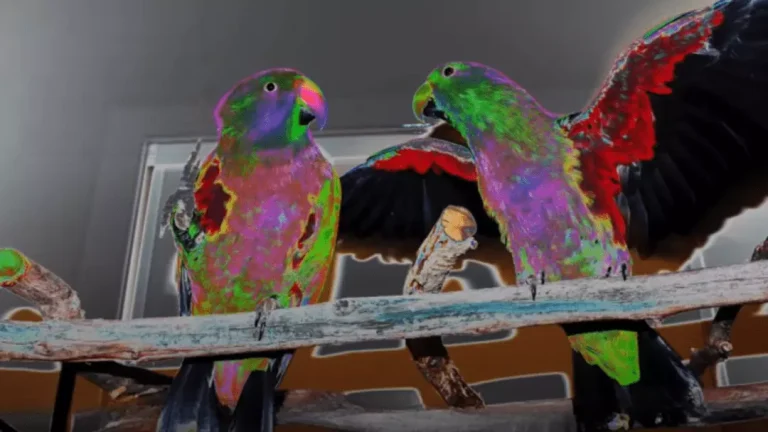Have you ever noticed globular-shaped eyeballs on parrots? Among the five senses, the parrot’s eyesight allows them for safe flight, flockmate search, food source find out, and threat assessment from the side of their heads.
But what is the capacity of a parrot’s vision? Or how do parrots see? A parrot’s range of eyesight is typically limited to about 180 degrees, but the eyes on the side of their head can let them watch almost 300 degrees. The bird can be comfortable seeing UV and fast-moving illumination, and the night view is a little weak for the parrots.
Reading this article will uncover the way parrot’s eyesight work, plus we will look for a comparison part between parrot vs human eyes. For further details on the parrot’s vision, see the next section!
Understanding the Basics: Parrot vs. Human Vision
Humans, with their trichromatic vision, can perceive three primary colors: red, blue, and green. Parrots, on the other hand, are tetrachromats. This means they have an additional color perception, allowing them to see ultraviolet light, a spectrum invisible to the human eye.
This unique capability stems from the presence of a fourth type of cone cell in their eyes, specifically designed to detect ultraviolet light.
What Is Parrot Vision Like?
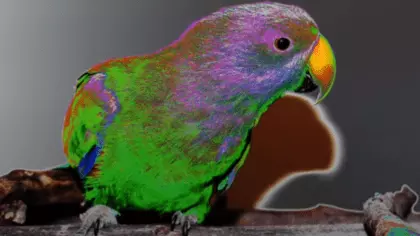
Diurnal birds like parrots have excellent daytime vision. Compared to humans, birds have better vision.
For example, if you go for a water bottle, you will know how far you need to reach out. But when you’re standing in an open field and spot a little dot on the ground, which is far away, you cannot detect things that well, and you cannot even tell how far it is. But the parrot can detect the distance!
Also, African grey parrots have the intellectual ability to distinguish between different color tones. However, checking the facts will clarify the parrot’s eyesight power.
- Due to the peripheral view, they can cover a broad space to see things.
- Parrot eyesight is usually tetrachromatic, so they can perceive wavelength in 300 to 400 nm area close to Ultraviolet.
- Since they are tetrachromats, they can watch four colors: red, blue, green, and ultraviolet.
- Their side eyes near the head have the visual power to see 300 degrees.
- The parrot can manage to see an eagle flying out and rising high above the clouds.
- Parrots are amazing at observing colorful objects better than humans.
- Even they can see phones, TV, iPad, or other devices with their visual power.
See More: African Grey vs Cockatiel
Are Parrots Color Blind?
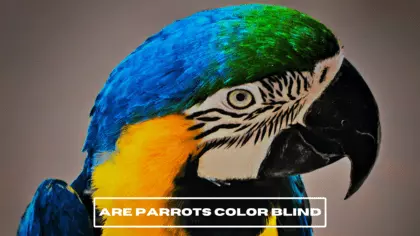
Many individuals believe that birds cannot see things in color. But it’s a myth about the loving feathered friend. Like humans, parrots have all five senses, especially eyesight, to see colorful things. Rather, they can detect the ultraviolet spectrum, which humans cannot see. As we stated earlier, parrots have a tetrachromatic vision so that they can observe colors such as:
- Ultraviolet
- Green
- Red
- Blue.
Unfortunately, parrots lack night vision, making them sensitive birds at night. However, nocturnal birds like owls can see during the night despite poor color vision in the daytime.
How Do Birds’ Eyes Work?
Birds like parrots or pigeons have monocular vision, which makes sitting easier for both eyes to focus on any object. Typically, the bird’s eye contains two different types of light receptors:
- Rods are good for night vision due to their sensitivity to low light levels.
- Cones help them to identify various light colors.
Usually, the rod and cone cells are organized in the retina, which is covered by a layer of cells known as the choroid, where the choroid helps shield the retina from UV radiation.
On the other hand, photoreceptor cells transform light into electrical commands. Then, the optic nerve gets the commands, and impulses are sent to the brain by the nerve. Plus, the parrot’s brain recognizes the signals before releasing them to its eye muscles.
Besides all these things, a little blind spot is seen in the back of the parrot’s head. They can always get notified where they are going and keep their eyes active to keep the eye out for prey and find food every time.
How Do Parrots See: Unveiling Birds Vision Power
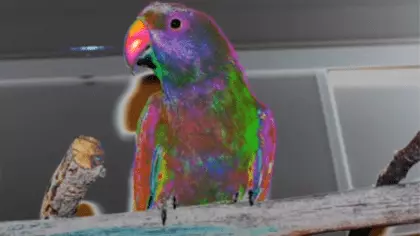
Parrots can see nearly 270° to 300° of peripheral vision of surroundings. They can sense where they are going and also keep their eyes always out for any enemies that could try to attack them. Overall, they have a large field of sight and fewer blind spots.
The unique visual eye system also collects lights and works to achieve any complicated processing of sight. However, learn more facts about the visual power of parrots in the next section!
- Have a horizontal view of the field.
- Parrots have Monocular eyesight.
- Eyesight coverage is 300 degrees.
- They can detect light faster.
- A better view of any moving object.
- On average, the visual pace of parrots is 120 frames every second.
The Anatomy of a Parrot’s Eye: More Than Meets the Human Eye
- Iris: The colored part of the eye, which controls the amount of light entering the eye.
- Pupil: The black center of the eye, which adjusts its size based on light conditions.
- Retina: The innermost layer of the eye, containing cells that respond to light.
- Fovea: A small depression in the retina where visual acuity is highest.
Did You Know? Parrots have a wider field of view than humans due to their eyes’ side positioning, ranging from 180 to 300 degrees!
Do Parrots Have Blurry Vision?
Actually, not blurry, but the parrot’s vision range could be better in the night mode. Parrot’s eyesight has a lower clarity than that of raptors but is better than human beings.
Sometimes the cloudy weather may disturb them from seeing everything. And if the parrot eye infection treatment becomes mandatory, it indicates they do not see things properly.
The Evolutionary Advantage: Why UV Vision?
The ability to see ultraviolet light offers parrots several advantages. For instance, many fruits and berries, which are a part of a parrot’s diet, reflect UV light. This makes it easier for parrots to spot their food. Additionally, UV vision plays a crucial role in mating, as certain plumage patterns are only visible under UV light.
How Do Parrots See The World?
Unlike people or other animals, such as owls, falcons, or hawks, ‘s eyes positioned close to each other and facing forward, parrots have a different level of seeing the world. They can see everything much sharper, wider, and flatter.
Though they have to turn their heads to see anything, they can see farther too with having eyes on the side. Birds use their vision to find partners, find food, and look for enemies. In general, the human retina contains three cone cells: red, blue, and green, whereas parrots have four color-seeing abilities that additionally can see Ultraviolet.
How Do Parrots See Humans?
Parrot’s views of humans will be more vibrant with sharp distinctions between colors that appear to be visually similar. Check the facts about eyesight to understand how the bird will see humans.
- In actuality, the bird’s eyes are positioned for having binocular vision, allowing them to judge distances accurately.
- An additional transparent moveable membrane covers two eyelids that vertebrates usually have.
- Despite having pecten oculi in birds, the internal anatomy of the bird’s eye is identical to other vertebrates; consequently, the vision is stronger than in mammals.
How Do Parrots See Light?
Birds can distinguish between ultraviolet and visible light wavelengths. Therefore, compared to other mammals, parrots’ retinas have more light receptors and nerve connections between photoreceptors and the brain.
The color rendering list, a scale used to determine how quickly the source-like bulb releases light, might impact the parrot’s state of mind. In addition, low lighting and continuous flickering may interfere with the parrot’s eyesight.
Can Parrots See In The Dark?
Parrots can see at night, but their eyesight is very poor. They are diurnal birds that are active during the entire day. Also, they need a period of complete darkness to rest or sleep, so the nighttime is their ideal period.
However, dark vision blurred vision makes it difficult for them to see in dim light areas. The bird’s eyes have fewer rods and cones than human eyes, indicating fewer photoreceptors that can detect the sense of light.
How Do Birds See With Eyes On Side Of Head?
Birds typically have side eyes near their heads. A wide field of view or monocular vision is what a parrot has. Additionally, they have sharp stereo eyesight in front of them.
Birds like parrots can use their eyesight from both left and right to gather deeper environmental information than you can ever see. It’s possible due to the brain’s capacity to absorb two diverse images from the sides.
The positioning of the eyes offers good vision, and it helps the bird to remain safe from any evils plus, finding food can also be confirmed with the eyes. As we stated earlier, the viewing angle ranges from 180 to 300 degrees.
So, the eyes can cover a long space better than human beings. However, ensure you don’t miss out on the parrot and human vision power comparison in the upcoming section.
Parrot Vision VS Human Vision
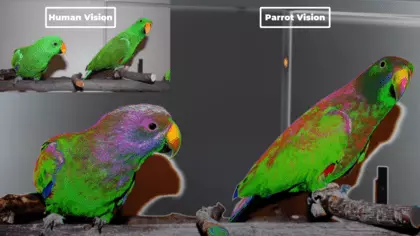
Throughout the article, we discovered that parrots’ visions are always higher than human beings. But in what cases parrots’ eyesight is more powerful? Let’s discover the answer!
| Parrot Eyesight | Human Eyesight |
|---|---|
| Parrots have much better and sharp vision. | Humans have less sharp eyesight. |
| Light wavelengths like ultraviolet can be seen by parrots. | Humans can only perceive three colors: Green, Blue plus Red but they cannot see Ultraviolet. |
| Parrots have cones for tetrachromatic shades of vision where you see the visible light spectrum. | In human eyes, the photoreceptive cones have only three varieties. |
| Birds like parrots have approximately 100,000 cones per square mm. | Only 10,000 cones per square mm are present in human eyes which is 10 times less than in bird’s eyes. |
FAQ
We already talked about the eyesight of parrots, so you have understood this feather friend’s capacity to watch things. But for the curious mind, we have a Q&A section that will share more information about the bird’s limitation of watching.
How many Colours can parrots see?
Birds like parrots can usually see all the colors, similar to humans. However, parakeet birds are tetrachromats or have four various receptors such as:
1. Ultraviolet
2. Green
3. Blue
4. Red.
How do African grey parrots see?
Generally, the African Grey parrot’s eyes are on the sides of their heads and have monocular eyesight. They usually lean their head and watch things around them. Despite being able to see ultraviolet and motion light, the low-level light bulb can occasionally bother them.
Can parrots see in front of them?
Parrots can see a wide area to the front side, and a long space to their side area since their field of view is quite higher and can cover around 300 degrees.
Do parrots see the same colors as humans do?
They indeed perceive color similarly to mammals or humans. Rather birds can see colors that humans cannot see because parrots have an ultraviolet range. Actually, we humans have fewer eye cones which are different from bird cones.
Can parrots see TV?
Typically, we use RGB or three colors on the TV. Therefore, a parrot can see pictures or television programs on the screen unless they are blind or visually restricted.
Wrapping Up
Parrots, with their unique visual capabilities, offer a fresh perspective on the world. Their ability to see ultraviolet light, coupled with their intricate eye anatomy, makes them one of nature’s marvels. As we continue to study and understand these birds, we gain deeper insights into the wonders of the animal kingdom.
They can detect 180 to 300 degrees around the field from a fixed point to understand the distance of objects and enemy attacks and to hunt their food. In addition, they have remarkable ultraviolet-vision capabilities that make them far superior to human vision. And keep in mind that they have some weakness in the dark but the front plus side view can aim perfectly.
References:
- https://animals.mom.com/advantages-disadvantages-bright-colors-parrot-8261.html
- https://www.quora.com/How-good-is-the-eyesight-of-a-parrot-How-does-it-compare-to-humans
- https://www.allaboutparrots.com/how-well-can-parrots-see/

Hi, I’m Regina Rios. Just another bird lover who loves to share knowledge from personal experience. I’ve grown up with pet birds since childhood as my mommy also loves birds. As I can’t pet many birds in open air in my house as my mom does; I created my first bird cage on my rooftop using wood, copper wire, and a metal shed in 2018 and start collecting pet birds. Now, I have so many pet birds such as Macaws, Parrot, Cockatiel, Parakeet, and others. Not only that, if I see natural birds are injured I keep them in my house until they get well. Now, my hobby becomes my income source as my home birds have babies and I sell them to birds lover like mine. I’ve created this blog to inspire others bird owners by sharing my personal knowledge. Good Luck!

